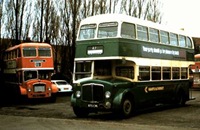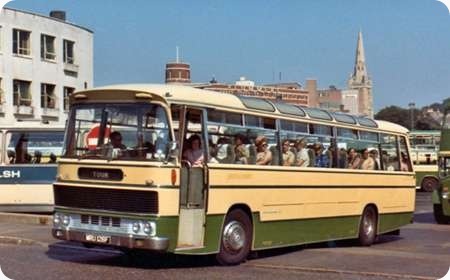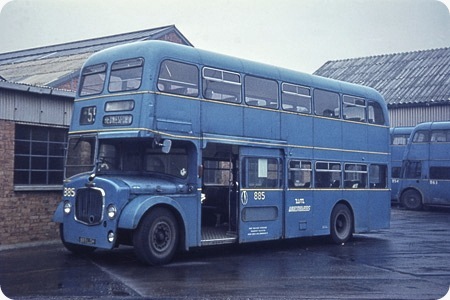Hants & Dorset – AEC Regent V – 975 CWL – 3475
Hants & Dorset Motor Services
1958
AEC Regent V LD3RA
Park Royal H65R
975 CWL is an AEC Regent V of the LD3RA variety. She was new in 1958 and has a Park Royal body seating 65. New to City of Oxford as their 975, she is seen in the yard of the Hants & Dorset depot in Southampton, still in Provincial (Gosport & Fareham) green and cream but with Hants & Dorset fleetname in NBC style. It’s April 1975 and she is between duties on the 47 Winchester service.
Photograph and Copy contributed by Pete Davies
16/03/14 – 09:42
A beautifully balanced classic design. What were BET and PRV thinking when they let those dreadful steel framed monsters loose on the world. I cannot believe it was impossible to produce a better design – just because they had steel frames. As was pointed out recently, sticking a Beverley Bar outline on a Bridgemaster worked wonders at East Yorkshire.
David Oldfield
16/03/14 – 09:43
It’s a long time since I submitted this, because so many of you have been sending in far better views, but I have a vague recollection the original text said that she is preserved.
Pete Davies
16/03/14 – 11:55
With only 65 seats in a 30ft body, the legroom must have been quite generous!
Chris Barker
17/03/14 – 07:45
I have this listed as preserved in Kidlington but have never seen it.
Ken Jones
17/03/14 – 17:33
Yes — preserved awaiting restoration.
Philip Lamb
17/03/14 – 17:34
This picture sums up for me the confusion of the early NBC era. It’s a green Hants & Dorset bus, but it’s not H&D Tilling green. It’s in Provincial green/cream, but not their traditional style. It’s a BET origin bus operating for a former Tilling company. (OK, Hants & Dorset operated some AEC Regent III’s earlier). In the background is a Lodekka, presumably a Hants & Dorset bus, but in red, not in green! Well, it did all settle down of course to just red or green in NBC shades, until Confusion Stage 2 arrived with deregulation. Hants & Dorset survives (sort of) under the fleet name "Damory Coaches", operating some stage services in Dorset in a rather non-descript grey livery. It’s part of Wilts and Dorset, which is part of Go Ahead. Yes, times have moved on. The Regent V in the picture does still look good, and was splendid in it’s original City of Oxford livery.
Michael Hampton
18/03/14 – 08:23
Very generous, Chris, most 30ft deckers of this layout were usually around the 73 seat mark.
Ronnie Hoye
18/03/14 – 10:55
These buses were known in Oxford as "Queens’ due to their size and indeed majestic appearance. 65 was later to become the standard COMs seating capacity for double-deckers with centre gangway in the upper saloon until the arrival of the first Fleetlines, following the first batch of Bridgemasters which seated 72. Subsequent Bridgemasters and the Renowns had a shortened rear overhang and were all 28-ft long 65-seat forward-entrance vehicles — not quite as roomy as the Queens! The five Lolines were forward-entrance 63-seaters.
Philip Lamb
18/03/14 – 10:57
I have always presumed that the reason for 65 seats in a 30ft body was in order to comply with an agreement with the staff in respect of maximum capacities – such agreements were common at the time. Having said that, Oxford’s first Bridgemasters (306-15) were 72-seaters – there may have been a ‘no standing passengers’ agreement, or restrictions on which routes they served. Anyone know the full story?
Later Oxford Bridgemasters (316-28) and all the Renowns (329-71) were short 65-seaters.
Oxford purchased sixteen 30ft Regent Vs in late 1957/early 1958 – eight with Weymann bodies (964-71) and eight Park Royal (972-9). All were H37/28R while with Oxford.
As far as I am aware, all the above sixteen went for further service with other operators after sale by Oxford. Stevensons (of Spath) upseated 966 and fitted platform doors, making it H41/32RD. Laycocks of Barnoldswick fitted doors to 968, but left the seating as it was – as 968 was replacing an accident-damaged 53-seater, the capacity perhaps wasn’t seen as critical. Were any of the others upseated, or fitted with doors?
David Call
18/03/14 – 13:48
Michael, the Hants & Dorset Lodekka with the T style indicator display you mention is XPM 47, new to Brighton Hove & District.
Pete Davies
18/03/14 – 17:26
Thank you, Pete D for the info about the red Lodekka in the background – doesn’t it just add to the glorious (or inglorious) mix of events at that time? Although of Tilling origin, it’s original colours were neither tilling red or green, but a handsome red and cream!
Also, a correction. I have passed several Damory vehicles today, and all were a deep blue, quite smart if admiring modern vehicles. Perhaps the grey was a passing phase, or my poor memory.
Michael Hampton
19/03/14 – 07:27
No, Michael – our successors in title to the Hants & Dorset "COMPANY" name, if not the fleetname, are like the rest of the ‘Go South Coast’ group in that they don’t seem able to keep a livery for long. Could be Worst (f), of course!!!
Pete Davies
19/03/14 – 07:28
969 gained platform doors when owned by Leon of Finningley.
Keith Clark
19/03/14 – 16:27
On an isolated trip into Damory country some years ago, I seem to recall seeing the buses in light grey and white, perhaps another passing phase, Michael!
Chris Hebbron
20/03/14 – 17:21
I don’t recall seeing any grey, Chris, but certainly turquoise has appeared in the past!
Pete Davies
22/03/14 – 08:23
I did a double-take when I saw this photo as I thought Pete Davies must have been standing next to me when he took it. However, my photo of this bus in the same place has a different route number and different vehicles in the background. H&Ds vehicle shortage was so bad at this time that I used to cycle to Shirley Road and Grovesnor Place every Sunday morning to see what had turned up that week – this one was a surprise though. I believe it lasted 5 weeks before the crews blacked it! I was told that the cab window had a habit of randomly dropping out over the bonnet!
Phil Gilbert
22/03/14 – 15:37
Phil G, most of my views at this location were taken during the working week, rather than at weekends, and usually during the lunch break.
Pete Davies
24/05/14 – 08:30
I used the ‘-CWL’ Regents in the late ’60s when travelling on the old ‘3’ service that ran along Walton Street, and they shared the route with (mostly)Renowns and Bridgemasters until the sudden arrival of the first ‘G’ reg., N.C.M.E. bodied Fleetlines that must have been the last ‘true’ Oxford’ double-deckers to keep both the old livery and the single-panel front route-number/destination display. With the Daimlers, a new, racier, ‘go faster’, ‘Oxford’ transfer appeared, smaller and less ‘stuffy’ than the old one. As for the roomy Regents, I always thought that the curvy bodywork of the second, Park Royal, batch helped redeem the plainness that came with the tin front: I never thought that any of these buses would survive their (routine) early retirement by C.O.M.S. and it was a surprise to find that ‘975’ may still be around as another potential showcase for the attractive old ‘Oxford’ livery (the ‘magic’ of the scheme was lost, in my view, when the it became a plain, two-colour affair).
I’ve been away from the Oxford area for decades and came across the correspondence on the ‘long Regents’ by accident. If my observation about ‘975’ gets posted, could I ask if anyone can explain why Oxford was flooded with ‘alien’ two-man double-deckers (such as Aldershot & District’s Loline 1s and East Kent’s Regent Vs) in the late ’60s? Was this an early manifestation of the N.B.C. homogenisation that would bring the inevitable Bristol VRs, or was their some kind of operational crisis that required a ‘loan out’ from other operators.
John Hardman
25/05/14 – 09:28
Re vehicle shortages in Oxford. In 1981/82 I was working in "The City" and attended a talk given by the head of City of Oxford M.S.
He said that every time the hourly pay rates increased in the Cowley car factory, the mechanical/engineering staff left Cowley Road depot for more pay. So it could well have been a lack of engineering staff, until the next pay rise on the bus side of the equation.
Eventually COMS moved the engineering facility to Witney, so as to make it uneconomical to commute to the car factory in Cowley.
Dave Farrier
25/06/14 – 08:19
Dorset Transit buses were white, light grey and orange- there were a couple of Leyland National 1’s at least- not sure if there were other types. I have seen pictures of them parked up amongst Damory vehicles, but don’t know if there was a connection.
Mark
02/05/16 – 06:40
Reference the vehicle shortages, that was indeed the case – engineering staff shortages. It became a major embarrassment at Oxford (and further afield) in the early days of NBC. So they flooded the streets with unconventional vehicles (for Oxford streets) that were running well while the maintenance was transferred to other companies.
Alan O. Watkins
 Vehicle reminder shot for this posting
Vehicle reminder shot for this posting
16/10/17 – 07:02
Just a note to say that 975CWL is still alive, albeit still awaiting finishing off. 75% of the major work has been completed but other projects have recently had priority and I would also like to see 975 completed before I "pop off"
Regarding the vehicle shortages, yes staff was a part off the problem but a major factor was the lack of AEC engine parts, notably 470 & 505 pistons and liners which were in very short supply and caused most of the COMS fleet of Reliances and Swifts to be off the road at the same time. Also a lot of the cooling systems were in bad shape due to the resistance to using anti-freeze in the early sixties……………and it came back to bite them!
When a new Chief Engineer was appointed in 1973 there was much needed investment carried out in the Engineering department with new facilities for annual MOT preparation made at Chipping Norton Depot, not Witney although this depot was also enlarged to cope with the extra allocation.
In 1973 25 Fords were introduced to replace the Reliances………but that is another story!
Grahame Wareham
Quick links to the - Comments Page - Contact Page - Home Page



